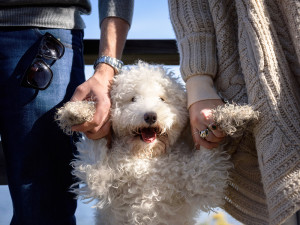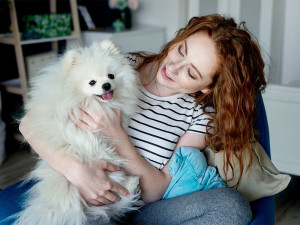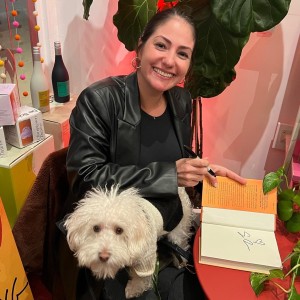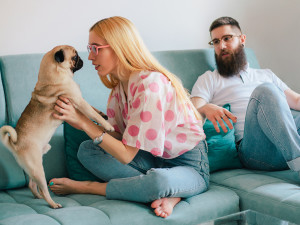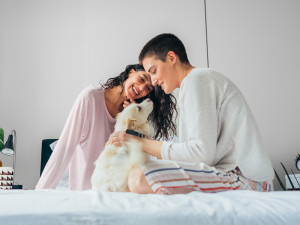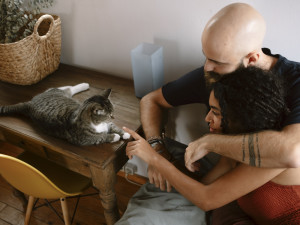What Does It Take to Co-Parent a Pet With Your Ex?
It’s definitely not for everyone. Here are five stories of pet co-parenting to keep in mind.
Heavy Petting is a weekly column full of relationship advice for pet parents — so you and your boo don’t end up fighting like cats and dogs over the cat and dog.
Breakups are brutal. Even if you don’t have kids, you still have to split up the fancy dishes, the bedroom furniture, the good wine glasses (not unimportant stuff). But, as Kinship’s August cover star, corook, muses in their heart-wenching song “The Dogopens in new tab,” the big, horribly difficult question for split-up pet parents is: “Who gets the dog?”
Sometimes, pet parents reach the conclusion that many parents of children do: split custody. These days, more and more people are co-parenting their pets — with varied results. Kinship talked to five former couples about how they maneuvered the logistics and emotions of pet care after splitting up. One former couple is still sharing the responsibilities of caring for their pup. Most of them tried co-parenting for a period of time before deciding it wasn’t for them. All of them did what was best for their families after the split. None of them would say this is easy.
When It Works, It Works
Despite the hiccups and failed attempts, co-parenting a pet can work in the right circumstances. Sophia, who lives in Brooklyn, and her partner split amicably back in 2018 after four and a half years together. Toast, their Pit Bull / Jack Russell mix, was a little over a year old at the time and had been living with them for 11 months.
How much do you spend on your pet per year?
“We were very aware of how much we both loved our dog and agreed that we wouldn’t take her away from the other one,” Sophia recalls. “It was just something we couldn’t do to each other.”
Because of this, Sophia and her ex decided to co-parent Toast. They landed on an alternating three-week schedule, split finances, like vet bills and health insurance 50/50, and agreed to remain consistent with walking routines and training. Maintaining this general structure was key to the success of their arrangement.
In the beginning, Sophia acknowledges that it was challenging to remain tethered to her ex. Although they ended their relationship on friendly terms, it was still painful to see each other. For a while, they kept their conversations brief and solely focused on Toast but, over time, they were able to become friends again. These days, they occasionally even get coffee and catch up when they meet to swap Toast.
Sophia says the arrangement has benefited Toast, too. “I’m sure she misses the other one when she’s with one of us, but she’s also super socialized,” she says. “She rides the subway, goes all over the city, meets tons of people, and is very friendly. I think it has made her braver.”
We Tried It…
Kaitlin, 37, from Hermosa Beach, California, and her ex-husband got their Golden Retriever, Parker, when they were dating. Eight years and three (human) kids later, the pair separated, and it was important that Parker still got to spend time with her siblings.
During the separation period, Parker went back and forth from Kaitlin’s ex-husband’s home to hers every few days with their children. Having Parker as a constant presence was comforting to her kids, who are eight, six, and five. “Parker is their fourth sibling,” Kaitlin says. “She’s been with us since they were babies, and they don’t know life without her.”
But when Kaitlin’s ex shared that he wanted her to retain sole financial and physical custody of Parker, she was surprised. “It’s interesting to watch someone you had a pet with since before you were married so easily hand her over,” Kaitlin shares.
After further discussion, Kaitlin and her ex attempted to follow a one-week on, one-week off schedule with Parker, allowing her to spend more time with their kids. But now that their divorce is finalized, Kaitlin has sole custody of their dog, which has recently become complicated.
“Parker is aging — she’s 13 now — and because I have sole custody I’ve decided I might leave her with my mom in upstate New York for her remaining years,” Kaitlin explains.
Her ex wasn’t happy with the decision and asked her to reconsider. But Kaitlin lives in a house with two sets of stairs, and being solely responsible for a senior dog — more frequent vet visits, health scares, and all — is not a small undertaking. “If I choose to leave her with my mom, he’s not going to have a say in it,” she says.
The Pitfalls of Co-Parenting
Here’s a question: Do you want to have to see your ex? For many couples, splitting custody of a pet simply isn’t worth maintaining contact with an ex. Sometimes, the pet can feel the negative effects of the tension between their parents.
Jenny, from New York City, learned this the hard way. “My ex and I shared custody of our dog, Rufus, for nine months, but every time we saw each other, he either had a passive aggressive comment or tried to convince me to get back together.”
To make matters worse, Jenny says Rufus seemed stressed during drop-offs and struggled to adjust, even having accidents in the house. Eventually, after talking to a trainer and consulting with family and friends, she decided that it was easier to go no-contact and let her ex keep the dog.
Although she misses Rufus, it was simply too painful to continue having her ex in her life after their relationship ended. “The whole thing was devastating,” she says, adding that she still thinks about Rufus all the time.
Emily, from San Diego, had a similar experience. After splitting with her boyfriend of six years, she hoped they would be able to co-parent their Maltese, Nora. But as her ex became increasingly unavailable to watch Nora during his custody weeks, Emily grew frustrated with their arrangement. When her ex ultimately told her he didn’t want to continue co-parenting, Emily wasn’t surprised.
“I think co-parenting a pet can really only work when both people are mature and on the same page about putting the pet’s needs first,” she says.
When a Clean Break Is For the Better
Anya, who lives in New York City, and her ex never even had a conversation about sharing custody of their six month old puppy, Moose. During their relationship, Anya was Moose’s primary caretaker, so she kept him by default.
While she says a co-parenting arrangement would have been hard for her emotionally, she would have taken alimony. “The cost of neutering, vet bills, food, training, and a dog walker have all been expensive.”
Despite the costs and responsibilities of being a single dog mom, Anya says a clean break was the healthiest option for her — and Moose. “In the beginning I definitely noticed Moose missing my ex,” Anya remembers. “He seemed sad and confused and would wait for him by the door. But now he’s doing really well; it’s me and Moose against the world.”
Considering co-parenting a pet? Sophia has this piece of advice: “Behave fairly in the beginning; it sets the tone. Your dog is hopefully going to live a long time, so hopefully you’ll be doing this for a long time. Also: you’re going to be tempted to be selfish and want your dog as much as possible, but try to remember that your ex gets as much benefit from the dog as you do. If you can set those feelings aside, it will help make things as equitable and sustainable as possible.”




